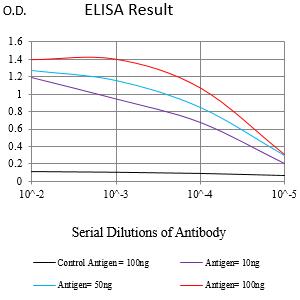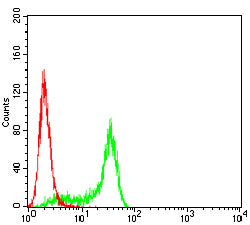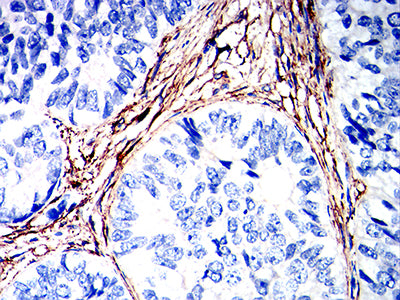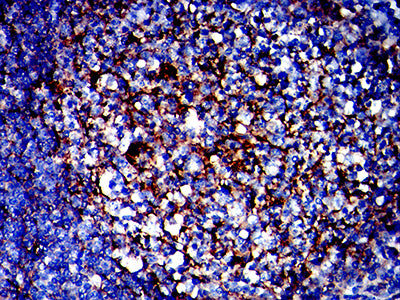



| WB | 咨询技术 | Human,Mouse,Rat |
| IF | 咨询技术 | Human,Mouse,Rat |
| IHC | 1/200 - 1/1000 | Human,Mouse,Rat |
| ICC | 技术咨询 | Human,Mouse,Rat |
| FCM | 1/200 - 1/400 | Human,Mouse,Rat |
| Elisa | 1/10000 | Human,Mouse,Rat |
| Aliases | OBIF |
| Entrez GeneID | 338773 |
| clone | 1B5E1 |
| WB Predicted band size | 29,2kDa |
| Host/Isotype | Mouse IgG2a |
| Antibody Type | Primary antibody |
| Storage | Store at 4°C short term. Aliquot and store at -20°C long term. Avoid freeze/thaw cycles. |
| Species Reactivity | Human |
| Immunogen | Purified recombinant fragment of human TMEM119 (AA: 118-283) expressed in E. Coli. |
| Formulation | Purified antibody in PBS with 0.05% sodium azide |
+ +
以下是关于TMEM119抗体的3篇代表性文献及其摘要概括:
---
1. **文献名称**: *A novel microglial subset plays a key role in neuroinflammation via TMEM119 signaling*
**作者**: Bennett ML, Bennett FC, et al.
**摘要**: 本研究首次证实TMEM119抗体可作为小胶质细胞的特异性标记物,区别于中枢神经系统中其他类型的巨噬细胞。通过免疫组化和流式分析,证明TMEM119在稳态和炎症条件下对小胶质细胞具有高度特异性,为神经炎症研究提供了新工具。
---
2. **文献名称**: *TMEM119 marks a subset of microglia in the human and mouse brain*
**作者**: Satoh J, Yamamoto Y, et al.
**摘要**: 作者通过多物种(人类和小鼠)验证,表明TMEM119抗体能特异性标记稳态下的小胶质细胞,且其表达在神经退行性疾病中显著下调。该抗体成为区分小胶质细胞与其他中枢神经系统巨噬细胞的关键标志。
---
3. **文献名称**: *The TREM2-APOE pathway drives neurotoxic microglial states in Alzheimer’s disease*
**作者**: Krasemann S, Madore C, et al.
**摘要**: 研究利用TMEM119抗体结合单细胞测序技术,揭示了阿尔茨海默病模型中小胶质细胞的异质性。TMEM119表达与疾病进展相关,其抗体可用于追踪病理状态下小胶质细胞的功能变化。
---
4. **文献名称**: *Microglial TMEM119 deficiency promotes neuroinflammation by regulating glycolytic metabolism*
**作者**: Matsuda T, Murakami Y, et al.
**摘要**: 通过构建TMEM119基因敲除模型,结合抗体标记技术,发现TMEM119通过调控糖代谢影响小胶质细胞活化。该抗体为研究代谢与神经免疫的关联提供了重要手段。
---
以上文献均聚焦于TMEM119抗体在标记小胶质细胞、区分巨噬细胞亚群及疾病机制研究中的应用,涵盖基础验证与疾病模型分析。
The TMEM119 antibody targets the transmembrane protein 119 (TMEM119), a cell-surface glycoprotein predominantly expressed in microglia, the resident immune cells of the central nervous system (CNS). Discovered as a microglia-specific marker through transcriptomic profiling, TMEM119 distinguishes microglia from other CNS macrophages and peripheral immune cells, offering a valuable tool for studying microglial behavior in health and disease. Unlike traditional markers like IBA1 or CD11b, TMEM119 exhibits high specificity for homeostatic microglia, aiding in precise identification in tissue samples.
Structurally, TMEM119 contains a conserved transmembrane domain and a cytoplasmic signaling motif, though its exact functional role remains under investigation. It is hypothesized to participate in microglial sensing or communication pathways.
In research, TMEM119 antibodies are widely used to investigate neuroinflammatory and neurodegenerative disorders, such as Alzheimer's disease, multiple sclerosis, and brain tumors, where microglial activation or dysfunction is implicated. Recent studies also explore its expression dynamics in disease-associated microglia (DAM), noting potential downregulation during activation, necessitating complementary markers for comprehensive analysis.
Despite its utility, TMEM119's reliability may vary across species or pathological contexts, requiring validation in experimental models. Overall, it remains a critical reagent for advancing microglial biology and CNS disease mechanisms.
×